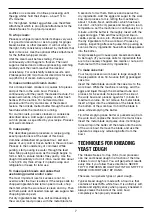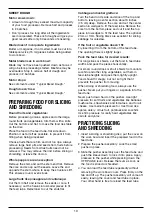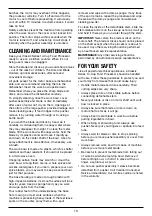
6
cheese and coconut will have the same texture as if
they had been hand-grated.
IMPORTANT: Never try to process cheese that is too
hard to cut with a knife. You may damage the blade
or the machine.
To chop parsley and other fresh herbs:
The herbs, the work bowl and the metal blade must
all be thoroughly clean and dry. Remove stems from
herbs. Add leaves to bowl and process until they
are chopped as fine as you want. The more herbs
you chop at a time, the finer chop you can obtain.
If completely dry when chopped, parsley and other
herbs will keep for at least 10 days, stored in an
airtight bag in the refrigerator. They may be frozen
for months, stored in an airtight container or bag.
To chop peel from citrus fruit or to chop sticky
fruit like dates or raisins:
For citrus, remove the peel with a vegetable peeler,
leaving on the white pith, which is bitter tasting. Cut
the peel into lengths of 2 inches (5 cm) or less and
process with
½ cup (125 ml) of granulated sugar
until finely chopped. This may take 2 minutes or
longer.
For sticky fruit like dates, raisins, prunes and
candied fruit, first freeze the fruit for about
10 minutes. Add to it some of the flour called for in
the recipe. Use no more than 1 cup (250 ml) of flour
for each cup of fruit.
To chop meat, poultry, fish and seafood:
The food should be very cold, but not frozen. Cut it
into 1-inch (2.5 cm) pieces to ensure an even chop.
Process no more than the recommended amount at
a time (see table inside front cover). Press the OFF/
PULSE lever 3 or 4 times until desired consistency
at a rate of 1 second on, 1 second off. Check the
texture often to avoid overprocessing. Use a spatula
to scrape food from the sides of the bowl as
necessary.
To purée meat, poultry, fish and seafood:
Prepare the food as described above. Pulse until it
is evenly chopped, then process continuously to the
desired texture. Scrape the bowl with a spatula as
needed.
Remember, you control texture by the length of
time you process. By varying the processing time,
you can get a range of textures suitable for
hamburgers, hash, stuffed peppers, rough patés
or smooth mousses.
To chop nuts:
Chop no more than the recommended amount at
one time. Press and release the OFF/PULSE lever
and check frequently to avoid letting powdered nuts
clump together in a nut butter.
When a recipe calls for flour or sugar, add some to
the nuts before you chop them – about
1
⁄
2
cup
(125 ml) for each cup of nuts. This allows you to
chop the nuts as tiny as you want without turning
them into a nut butter.
You can also chop nuts with a shredding disc. The
optional Fine Shredding Disc is particularly good.
To make peanut butter and other nut butters:
Process up to the recommended amount of nuts.
Let the machine run continuously. After 2 or
3 minutes, the ground nuts will form a ball that will
gradually smooth out. Scrape the sides of the bowl
and continue processing until drops of oil are
visible. Taste for consistency. The longer you
process, the softer the butter will be. For chunk
style, add a handful of nuts just after the ball of nut
butter begins to smooth out. To make cashew
butter, add a little bland vegetable oil. Processor nut
butters contain no preservatives. Store in the
refrigerator to keep them without separating.
To make flavoured butters, spreads and dips:
Cut room-temperature butter into tablespoon-size
pieces. Chop flavoring ingredients – anchovies,
cheese, herbs, etc. – fine, then process. Be sure
the work bowl is clean and dry. Add small, hard
ingredients like garlic and hard cheese through the
feed tube while the machine is running. Next, add
the butter and process until smooth. Add any liquid
ingredients last, while the processor is running,
and process just long enough to blend. Process
ingredients for spreads and dips in the same way.
They should be at room temperature and cut into
1-inch (2.5 cm) cubes, or added by tablespoonfuls.
To make mayonnaise:
The work bowl and metal blade must be clean and
dry. Use one whole large egg, or the yolks from two
large eggs. Mayonnaise made from yolks will be
almost as thick as butter. You should be able to
add
2
∕
3
cup (150 ml) of oil for each yolk or 1
1
⁄
4
cups
(300 ml) for a whole egg.
Process the yolks or egg with salt, mustard
and 2 tablespoons (30 ml) of vegetable oil for at least
30 seconds. Then, while the machine is running,
pour
1
⁄
4
cup (60 ml) of oil into the small pusher. After
it runs through the pinhole at the bottom, remove the
small pusher and slowly add the remaining oil while
the machine runs. See the recipe at the back
of this book.
To beat egg whites:
Use this method only for recipes that can be done
almost entirely by food processor.
The work bowl and metal blade must be absolutely
clean. Add 3 or more egg whites and press the ON
lever. Add about
1
⁄
2
teaspoon (2.5 ml) of lemon juice
or vinegar for every egg white. Vinegar makes stiffer
whites; its flavour is hardly detectable in cakes,

































